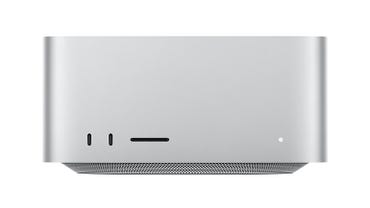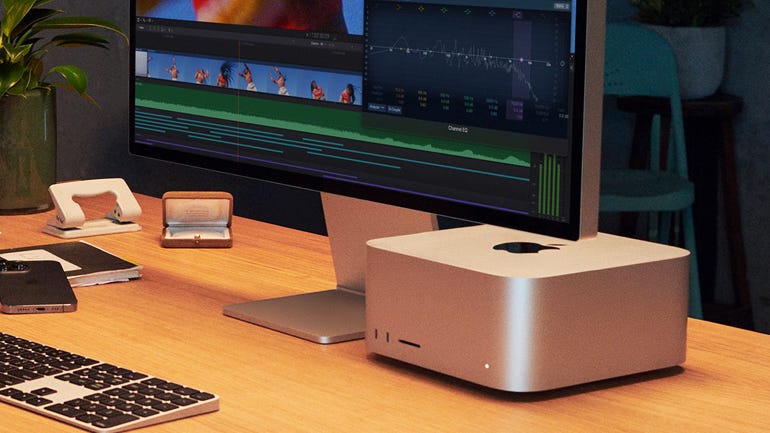
Apple Mac Studio: an M1 Max- or M1 Ultra-powered ‘Mac Mini on steroids’.
Image: AppleApple certainly knows how to keep a secret. Internet rumours surrounding Apple’s 8 March event centred around a second-generation M2 processor, which would feature in a new MacBook Pro, Mac Pro, MacBook Air and/or Mac Mini. What the company actually came up with was another iteration of its existing M1 range — the M1 Ultra, which combines two 10-core M1 Max chips to create a 20-core SoC (system-on-a-chip) colossus.
And rather than using the M1 Ultra to upgrade an existing Mac, Apple came up with an entirely new design, called the Mac Studio. Apple also discontinued the Intel-based 27-inch iMac at the same time, making it clear that the Mac Studio, along with the new 27-inch Studio Display, was aimed at the many designers and creative users who have traditionally relied on the iMac as their main desktop system.
Like
- Compact design
- Workstation-class performance
- Good connectivity
- Runs cool and quiet
Don’t Like
- Expensive
- No internal expansion or user upgrades
- Monitor, mouse and keyboard are extra-cost items
Design & features
Available with either an M1 Max or M1 Ultra processor, the design of the Mac Studio is both strikingly new and instantly familiar, looking rather like a Mac Mini on steroids. It was instantly dubbed the ‘Mac Mini Pro’ by many Apple watchers, while the brave souls at iFixit described it as “more than a Mac Mini, but not quite a Mac Pro”, following a recent teardown.
Like the Mac Mini, the Mac Studio is sold without a monitor, mouse or keyboard. It has the same compact footprint as the Mac Mini, measuring 197mm (7.7 inches) square. The difference, of course, is that the Mac Studio stands considerably taller, at 95mm (3.7 inches), compared to the low-profile 36mm (1.4 inches) of the Mac Mini. Much of that extra bulk is devoted to a more powerful cooling system that can accommodate the heat generated by the M1 Max and Ultra processors. However, Apple has also improved the Mac Studio’s connectivity to meet the needs of professional users.
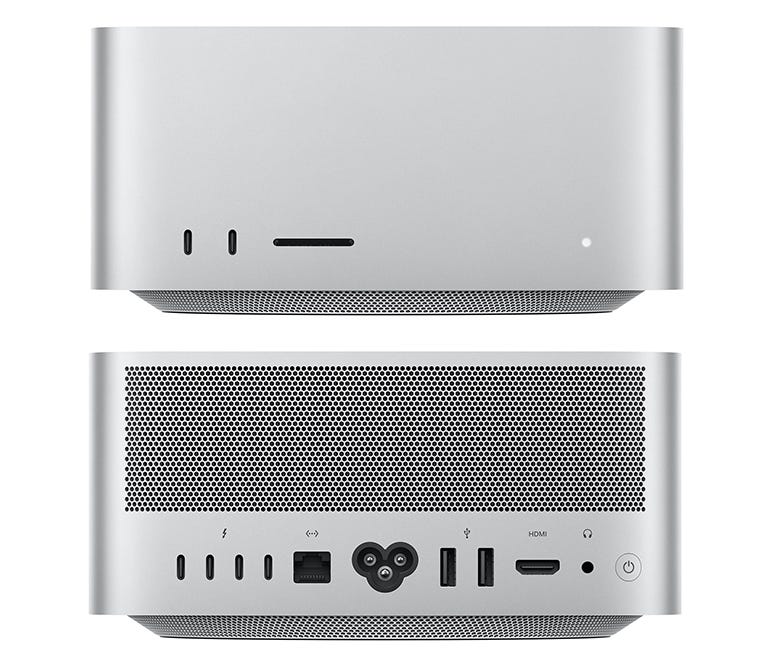
The Mac Studio has plenty of ports, front and back, but you can’t upgrade any internal components.
Images: AppleThere are four Thunderbolt 4 ports on the back panel, and one HDMI connector, with the multi-core GPUs provided by the M1 Max (24-32 cores) and Ultra (48-64 cores) allowing the Mac Studio to support four of Apple’s 6K Pro Displays and one 4K display. The back panel also houses two USB-A ports, 10-Gigabit Ethernet, and a 3.5mm headphone socket.
And, in a break with Apple tradition, the Mac Studio even has some additional ports on its front panel — so you no longer have to stand up and reach behind the Mac to plug in a memory stick or an SD card. If you opt for a top-end Mac Studio with the M1 Ultra processor then you get an SDXC card slot and two additional Thunderbolt 4 ports (supporting speeds of up to 40Gb/s), while the M1 Max version provides two USB-C ports (up to 10Gb/s) instead.
But, of course, it’s the M1 processors inside the Mac Studio that really set it apart from the more compact Mac Mini. As mentioned, the Mac Studio is available with either an M1 Max or M1 Ultra, the latter providing a 20-core CPU, 48 or 64 GPU cores, and a 32-core Neural Engine.
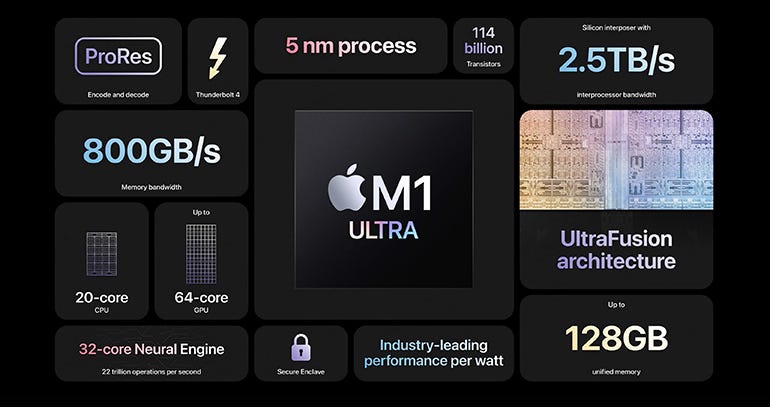
The top-end M1 Ultra is essentially two M1 Max chips bolted together using Apple’s on-die UltraFusion architecture.
Image: AppleBolting two M1 Max processors together isn’t a simple matter, so rather than connect them via the motherboard Apple has developed an on-die interconnect technology called UltraFusion, which allows MacOS to simply treat the M1 Ultra as a single processor. This means that software developers don’t have to rewrite their applications in order to utilise the M1 Ultra’s twin processors, allowing the Mac Studio to really hit the ground running.
The M1 Max doesn’t generate as much heat as the M1 Ultra, so it only requires an aluminium heat-sink, which results in a total weight of 2.7kg (5.9lbs). However, the greater power of the M1 Ultra requires a copper heat-sink, increasing the weight to 3.6kg (7.9lbs). Even so, that’s not much heavier than a large 16- or 17-inch laptop, and Apple is understandably proud of the fact that it has designed a desktop workstation that can fit into a backpack.
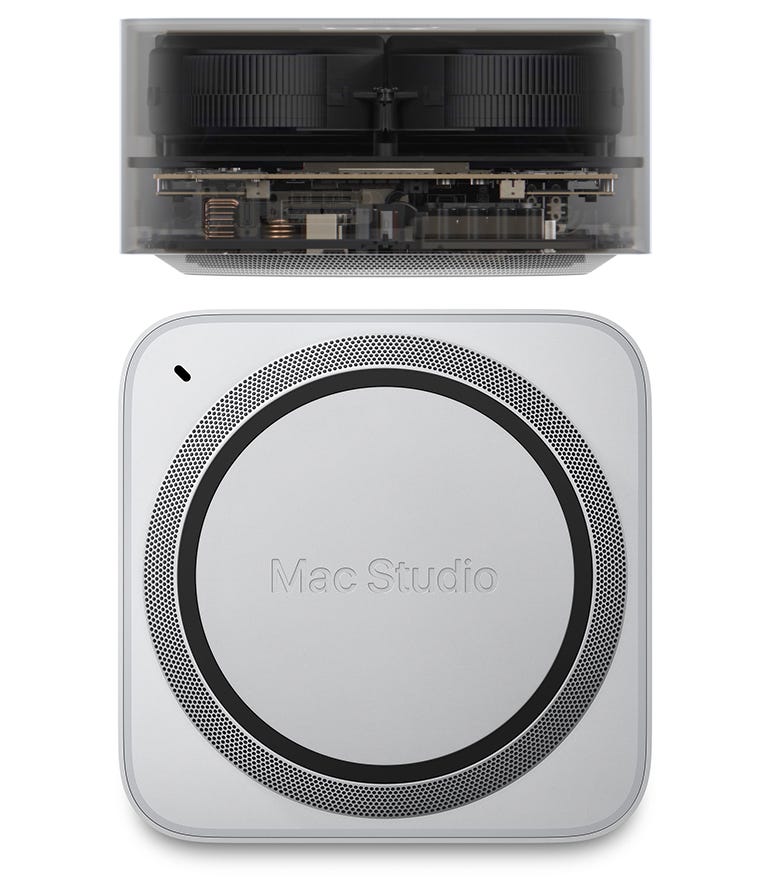
Despite the compute power packed into its compact chassis, the Mac Studio runs cool and quiet thanks to a thermal design that includes double-sided blowers, precision airflow channels and over 4,000 perforations on the back and bottom of the enclosure.
Images: AppleThe elephant on the desktop, though, is the fact that — yet again — Apple has designed a ‘pro’ desktop computer with absolutely no internal expansion ports.
We’ve been here before, of course, when Apple produced the equally striking ‘trashcan’ Mac Pro in 2013. That black, cylindrical design drew gasps when it was first unveiled, but it soon became clear that Apple had designed itself into a corner, and it spent years developing the current Intel-based Mac Pro with its battery of expansion slots and drive bays. It’s telling that the Mac Pro remains on sale, while the 27-inch iMac, as noted above, has now been discontinued.
Price & options
There’s a huge price difference between the two versions of the Mac Studio, with the M1 Max model starting at $1,999. That price includes an M1 Max with 10-core CPU, 24-core GPU, and 16-core Neural Engine, along with 32GB of integrated ‘unified’ memory and 512GB of solid-state storage.
However, opting for an M1 Ultra instantly doubles the price to $3,999. This provides you with a 20-core CPU (3.2GHz), 48-core GPU and 32-core Neural Engine, along with 64GB of and a 1TB SSD. However, you can also upgrade the M1 Ultra to provide 64 GPU cores for an extravagant $1,000 more, while doubling the memory to 128GB costs an additional $800, bringing the total price to $5,799.
It’s also possible to purchase the Mac Studio with up to 8TB of solid-state storage, which adds a hefty $2,200, bringing the total price to $7,999. However, most users will likely prefer to use more affordable external drives for additional storage.
Arguably, the entry-level Mac Studio with M1 Max represents a direct replacement for the discontinued 27-inch iMac but, of course, the price of the iMac included an integrated 5K display, whereas the Mac Studio doesn’t even include a keyboard or mouse, let alone a monitor. If you opt for Apple’s new Studio Display then you’ll have to budget at least $1,599 for that, although there are many less expensive 4K and 5K displays available from other manufacturers.
Performance
Benchmarking Macs that use Apple’s home-grown M1 processors remains problematic, as there are few cross-platform synthetic benchmarks that can compare M1 Macs with Windows PCs. However, we do have Geekbench 5 benchmarks for the 16-inch MacBook Pro with M1 Max processor, which makes for an interesting comparison with the top-of-the-range M1 Ultra that powered our Mac Studio review unit.
When running the Geekbench 5 CPU benchmark, the Mac Studio and MacBook Pro achieved identical single-core scores of 1790. However, the Mac Studio’s 20-core M1 Ultra leapt ahead on multi-core performance, scoring 24,050 — almost twice the score of 12,780 for the MacBook Pro’s 10-core M1 Max.
Here are these numbers compared to Geekbench figures for other M1-based Macs, along with the Intel-based Mac Pro and (now-discontinued) 27-inch iMac:
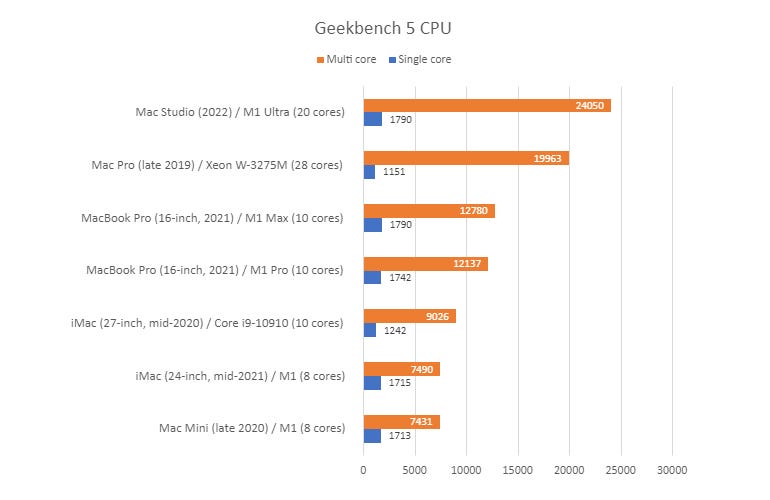
The Geekbench 5 graphics performance test (Compute) didn’t produce the same level of improvement: the M1 Ultra-based Mac Studio scored exactly 100,000 using the Metal API — around 53% higher than the 64,950 score delivered by the M1 Max-based MacBook Pro. Under the 3DMark WildLife Extreme graphics benchmark, the MacBook Pro achieved 121 frames per second (fps), while the Mac Studio was 72% faster, breezing ahead to 209fps.
Geekbench 5 Compute also allows for a cross-platform comparison, using the OpenCL API. This puts the M1 range — even the Ultra — a long way behind Nvidia’s high-end GeForce RTX 3090:
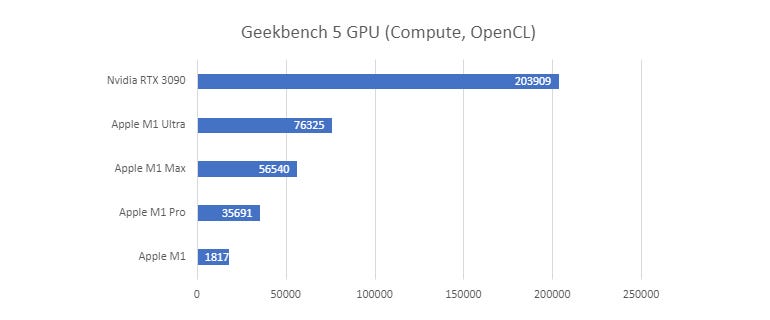
OpenCL clearly doesn’t show Apple Silicon in its best light, and to get the best GPU performance from the M1 Max and Ultra, you’ll want to seek out applications like Adobe Photoshop that run natively with Metal on Macs.
Despite the workstation levels of performance provided by the M1 Ultra, the fans in the Mac Studio were barely audible, even when running the demanding 3DMark graphics tests.
Conclusions
The Mac Studio is one of those designs that only Apple could come up with, providing a unique combination of power and elegance — as well as frustrations such as its lack of internal expansion and user upgrades. Some users will mourn the loss of the all-in-one 27-inch iMac, but the Mac Studio proves that Apple Silicon can deliver genuine workstation performance and gives the professional end of Apple’s desktop range a welcome shot in the arm.
Apple Mac Studio specifications
|
Chipset (SoC) |
Apple M1 Max (10 CPU cores, 24-32 GPU cores, 16-core Neural Engine) • M1 Ultra (20 CPU cores, 48-64 GPU cores, 32-core Neural Engine) |
|
Memory bandwidth |
400GB/s (M1 Max) • 880GB/s (M1 Ultra) |
|
RAM (unified memory) |
32-64GB (M1 Max) • 64-128GB (M1 Ultra) |
|
Storage |
512GB (M1 Max), 1TB, 2TB, 4TB, 8TB (M1 Max & Ultra) |
|
Audio |
1x speaker, 3.5mm headphone jack, multi-channel audio support over HDMI |
|
Connections & expansion |
Rear: 4x Thunderbolt 4 (DisplayPort, USB 4, USB 3.1), 1x RJ-45 Ethernet, 2x USB-A, 1x HDMI • Front: 2x USB-C (M1 Max), 2x Thunderbolt 4 (M1 Ultra), SDXC card slot |
|
Communications |
Bluetooth 5.0, Wi-Fi 6 (802.11ax), 10Gbps Ethernet |
|
Dimensions (WxDxH) |
19.7cm x 19.7cm x 9.5cm (7.7in. x 7.7in. x 3.7in.) |
|
Weight |
M1 Max: 2.7kg (5.9lbs) • M1 Ultra: 3.6kg (7.9lbs) |
|
Prices |
from $1,999 (M1 Max) • from $3,999 (M1 Ultra) |
RECENT AND RELATED CONTENT
Peek Performance showcases the triumph of Apple silicon
Apple M1 Ultra chip blows away the competition
Mac Studio vs. Mac Pro and Mac mini: Apple delivers extreme power
Apple’s new Mac Studio: The Mac Mini grows up
The best Macs: Is the Mac Studio or MacBook Pro right for you?
Read more reviews


